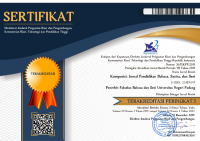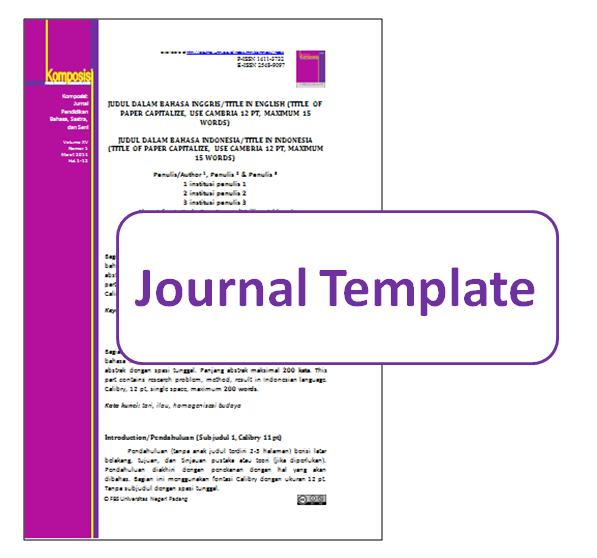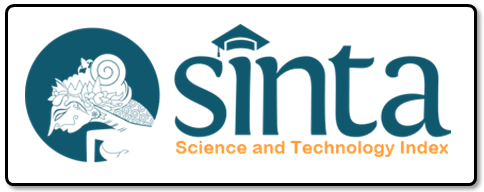Syntax Learning Using Syncronous and Asyncronous Method: Which Is Better?
Abstract
Keywords
Full Text:
PDF (Bahasa Indonesia)References
Abbasi, S., Ayoob, T., Malik, A., & Memon, S. I. (2020). Perceptions of Students Regarding E-Learning During Covid-19 at a Private Medical College. Pakistan Journal of Medical Sciences, 36(COVID19-S4), S57–S61. https://doi.org/10.12669/pjms.36.COVID19-S4.2766
Adnan, M., & Anwar, K. (2020). Online Learning Amid the COVID-19 Pandemic: Students Perspectives. Journal of Pedagogical Sociology and Psychology, 1(2), 45–51. https://doi.org/10.33902/jpsp.2020261309
Allam, S. N. S., Hassan, M. S., Mohideen, R. S., Ramlan, A. F., & Kamal, R. M. (2020). Online Distance Learning Readiness During Covid-19 Outbreak Among Undergraduate Students. International Journal of Academic Research in Business and Social Sciences, 10(5), 642–657. https://doi.org/10.6007/ijarbss/v10-i5/7236
Hermawan. Daniel. (2021). The Rise of E-Learning in COVID-19 Pandemic in Private University: Challenges and Opportunities. IJORER : International Journal of Recent Educational Research, 2(1), 86–95. https://doi.org/10.46245/ijorer.v2i1.77
Lestiyanawati, R., & Widyantoro, A. (2020). Strategies and Problems Faced by Indonesian Teachers in Conducting E-Learning System During COVID-19 Outbreak. Journal of Culture, Literature, Linguistic and English Teaching, 2(1), 71–82.
Madhubhashini, G. T. (2021). Challenges and Opportunities of E-learning Via Zoom. Proceeding of the 34th Annual Conference of the Asian Association of Open Universities, II(June), 375–382.
Mulyani, Fidyati, Suryani, Suri, M., & Halimatussakdiah. (2021). University Students’ Perceptions through e-Learning Implementation during Covid-19 Pandemic: Positive or Negative Features Dominate? Studies in English Language and Education, 8(1), 197–211. https://doi.org/10.24815/siele.v8i1.17628
Peimani, N., & Kamalipour, H. (2021). Online education and the covid-19 outbreak: A case study of online teaching during lockdown. Education Sciences, 11(2), 1–16. https://doi.org/10.3390/educsci11020072
Ramadhanti, D., Yanda, D. P., & Yenti, E. (2020). Peran Perpustakaan sebagai Pendukung Pembelajaran Jarak Jauh di Masa Pandemi Covid-19. Libraria: Jurnal Perpustakaan, 8(1), 1–30.
Shurygin, V., Berestova, A., Litvinova, T., Kolpak, E., & Nureyeva, A. (2021). Universal Models and Platforms in E-Learning. International Journal of Emerging Technologies in Learning, 16(9), 63–75. https://doi.org/10.3991/ijet.v16i09.19697
Subedi, S., Nayaju, S., Subedi, S., Shah, S. K., & Shah, J. M. (2020). Impact of E-learning During COVID-19 Pandemic Among Nursing Students and Teachers of Nepal. International Journal of Science and Healthcare Research, 5(3), 68–76. www.ijshr.com
Sugino, C. (2021). Student Perceptions of a Synchronous Online Cooperative Learning Course in a Japanese Women’s University during the COVID-19 Pandemic. Education Sciences, 11(5). https://doi.org/10.3390/educsci11050231
Ubaldo, E. F. (2021). Synchronous Web-Based Collaborative Writing: Attitudes of Learners Toward Working in Pairs and Small Groups. Studies in English Language and Education, 8(3), 935–951. https://doi.org/10.24815/siele.v8i3.20079
Wichanpricha, T. (2021). Synchronous Online Learning through Microsoft Teams at Tertiary Level: Academic English Course. Journal of Educational and Social Research, 11(5), 123–140. https://doi.org/10.36941/jesr-2021-0111
Yang, Y., & Cornelius, L. F. (2019). Students’ Perceptions Towards the Quality of Online Education: A Qualitative Approach. 861–877.
DOI: https://doi.org/10.24036/komposisi.v26i1.132495
Refbacks
- There are currently no refbacks.
Copyright (c) 2025 Komposisi: Jurnal Pendidikan Bahasa, Sastra, dan Seni

This work is licensed under a Creative Commons Attribution-NonCommercial 4.0 International License.
Komposisi: Jurnal Pendidikan Bahasa, Sastra, dan Seni, a peer-reviewed online journal in languages, literature, and arts education.
Printed ISSN 1411-3732, Online ISSN 2548-9097.
Currently, Komposisi: Jurnal Pendidikan Bahasa, Sastra, dan Seni is indexed by:
Published by:
Universitas Negeri Padang (UNP)
Address: Faculty of Languages and Arts (FBS) Universitas Negeri Padang.
Jl Prof. Dr. Hamka Air Tawar Barat, Padang - West Sumatera -Indonesia
Telp/Fax. +62751 7053363
Home page: http://ejournal.unp.ac.id/index.php/komposisi | e-mail:komposisi.fbsunp @ fbs.unp.ac.id | cc: havid_a @ fbs.unp.ac.id
https://m.certified-lighting.com/
slot resmi
situs toto
situs toto toto slot
Wanita Subang Beli mobil dari Nolimit city
Gatot kaca Buat TKW Jadi jutawan
Rahasia sukses bermain Mahjing wins
rahasia sukses bermain mahjong ways
div>












